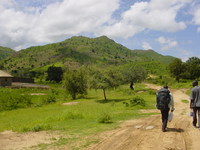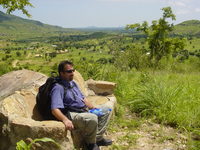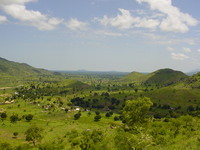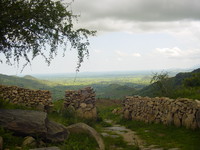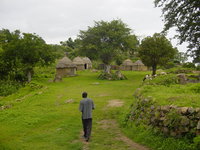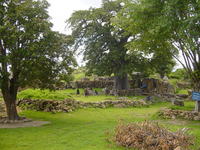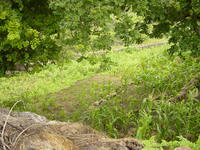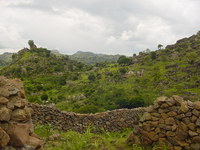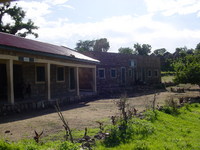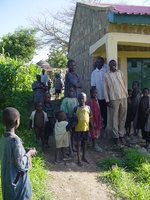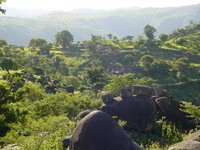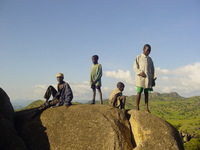Sukur Kingdom – day 1
I saw the Sukur kingdom mentioned in the Bradt guide to Nigeria a few months ago and decided to go there. Dave decided to come along after his re-entry visa was delayed, meaning he couldn’t join Karin and Jenny on their trip to Niger and Mali.
We met up on Jos on the Friday evening and stayed the night at PW and the next morning took public transport to Maiduguri. We were a bit worried we wouldn’t make it in time because the car took hours to fill but in the end we arrived around four thirty having left Jos just after ten.
Father Leo had arranged accommodation for us at the St Patrick’s Catholic Cathedral in Maiduguri, where we were welcomed by Father Marcel. We had something to eat, went for a little wander around Maiduguri and then had an early night.
After an early start Dave and I took machines to Bama motor park and then squeezed into an overloaded Golf (which smelled strongly of cow) for the 45 minute and 250 Naira journey to Bama.
In Bama we stopped behind a bus that seemed to already be full and ready to leave, but the driver of the Golf spoke to the conductor and they managed to lever us in. Bama to Madagali cost another 250 Naira each and took about an hour.
At Madagali we stopped for our breakfast of crackers and cheese. This was a bit of a disappointment, the crackers had obviously been stored too close to the mothballs and tasted pretty horrible.
We were now at the point where the guidebooks said transport becomes difficult, but that just proves how little the writers know about Nigeria. We strolled up to the crowd of men, buses and machines at the side of the road and asked about buses to Mildo. There isn’t a regular service, so we chartered a minibus for 1000 Naira.
Our driver said that we should go and visit the District Head before setting off up the hill to Sukur. We dropped outside his house and waited for him to finish conducting the service, he’s also the local representative of the Catholic church and Father Marcel in Maiduguri had mentioned him.
Father Marcel forgot to mention that the District Head speaks no English, so we managed to greet him in Hausa and then stand around uncomfortably while an interpreter was fetched. It seems that you have to ask him for permission to visit Sukur.
Next the interpreter, Johnson, sent our bags round to the bottom of the path to Sukur by motorbike and led us on a more direct route to the home of the National Commission for Museums and Monuments guide. When we got there we found out that we were supposed to have a letter from the NCMM giving us permission to visit. We told the guide that the District Head had given us permission and he eventually relented and got us to fill in some forms.
From the guide’s house it’s not far to the bottom of the hill. We walked past a small hotel that has been built in the style of local buildings and fits into the landscape well, unfortunately there’s no water so it isn’t open yet.
We finally set off up the hill, Johnson had insisted on carrying my rucksack but Dave was carrying his own and not letting me forget about it. The path up the hill is quite steep but little stone benches have been built so that you can stop on your way up and admire the beautiful views.
Dave eventually relented and we took turns carrying his bag up the stone path , which had obviously taken a lot of effort to build but hadn’t been maintained much recently.
As we reached the first gate of the Sukur kingdom and the path levelled out it started to rain lightly. Fortunately the rain didn’t get very heavy, so we just kept going. Soon after passing the royal burial ground some mud-plastered huts came into view, the guest huts at the royal palace.
The guest huts are in an outer compound of the palace, where the king meets with his advisers and title holders. He has a stone throne, there’s a little shrine and a few large trees for shade.
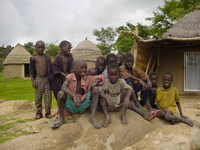
At the palace compound we were met by a crowd of small boys and someone was sent off to fetch the king. He arrived and greeted us in Hausa, the writers of the Bradt guide must have met a different king who could talk to them in “broken English”. He made a speech that Simon (the NCMM guide) translated for us and we thanked him for his welcome.
Next we were taken on a tour of the palace, which isn’t what you might expect from the name. It consists of several dry stone walls and gateways, with a little compound of huts where the king lives with his wife. There’s also a hut for the king’s horse, a bull-fattening pen and the hut formerly used for dispensing justice.
Once we were back at the asked if we could stay for a couple of nights and everyone became even more welcoming. Various people were dispatched to bring things for us, a guest hut was opened and a young local man called George was assigned to look after us. I gave the king some presents we had brought: cola nuts and some Danish cookies. He seemed quite happy.
Johnson and Simon the guide finally left, Dave and I were getting very hungry by this point and were desperately waiting for them to go so that we could have lunch. Dave had brought flat bread, houmous and processed cheese slices. The only slight problem was that we were plagued by flies all day, I’ve no idea where they all come from or why there are so many but Sukur is full of flies.
A little later the king was holding a meeting and George was taking the minutes so we wandered around a little bit.
The local primary education board had built a school last year, which still looks very new. It also seems to be the centre of local social life on a Sunday afternoon, with boys playing football, young men with a stereo and older men playing cards and drinking some evil-looking local spirit.
After the school we wanted to get up to the top of one of the nearby hills for a view of the palace. In the end we managed to explain (in broken Hausa and hand waving) and were guided up by a small boy in green shorts. Near the top there was a lot of scrambling up big rocks, so the locals had the amusing sight of two big Baturis being hauled up by the small boy.
The picture above left is the palace, above right are our guide and some onlookers.
In the evening some more small boys brought water for showers and a kerosene stove was fetched from somewhere inside the palace. We cooked pasta with tuna and cheese and then sat outside as the sun set. George had brought us some burukutu, a kind of beer made from millet that looks and tastes a lot like mud, and also insisted on washing up for us.
We eventually retired to our hut and settled on our creaky and uncomfortable bamboo beds for the night.
![[Nigeria]](/media/Flags/NGflagSmall.png)
